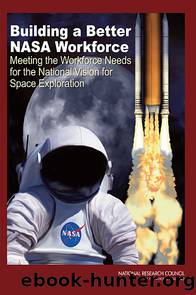Building a Better NASA Workforce: Meeting the Workforce Needs for the National Vision for Space Exploration by National Research Council of the National Academies

Author:National Research Council of the National Academies
Language: eng
Format: epub
Tags: Space and Aeronautics : Policy, Reviews and Evaluations
Publisher: NATIONAL ACADEMY PRESS
Published: 2007-06-29T00:00:00+00:00
The work of NASA scientists is unique in accomplishing the agencyâs mission of expanding human knowledge through space-based exploration. They provide a critical interface between the science community and the NASA engineers and managers who implement NASA missions, maintaining stewardship of the communityâs science priorities and ensuring that those priorities are held front and center in the execution of NASA scientific flight missions. NASA scientists also serve the broader science community through participation in the celestial navigation experience base maintained at the Jet Propulsion Laboratory, which is vital for supporting other NASA projects; the lunar sample curatorial facility in Houston; the National Space Science Data Center at Goddard Space Flight Center; and the microgravity drop tower facility at Glenn Research Center. In-house scientists also play key roles in focused R&D programs and shepherd technology development partnerships with academia and industry that enable future missions.
The roles NASA scientists play span all three phases of the exploration cycle: (1) the pre-formulation phase, during which they interface with the science community to ensure that high-priority future science goals are the focus of basic research, technology development, and mission concept development efforts; (2) the project development phase, when they serve as project and instrument scientists, among other roles, ensuring that mission science requirements are implemented to the fullest extent possible and engaging the science community in the process of implementing NASA missions; and (3) the mission operations/data analysis phase, when they continue to serve as project scientists and also are often responsible for administering the observing and guest investigator proposal review process and ensuring that data are calibrated, distributed to the science community, and archived for external use.
Just as NASA engineers and managers must be able to acquire and continue to improve their core capabilities and maintain their technical capabilities through hands-on experience, so also must scientists maintain a presence in the science community as practicing scientists to continue to perform their duties. This work as practicing scientists, i.e., basic research, is typically done during the first and third phases of the exploration cycle outlined aboveâthe pre-formulation phase often entails basic R&D, and data analysis is fundamentally a scientific research activity. The key is that this work is best performed within the context of a NASA scientistâs job to interface with the broader community and provide stewardship of community priorities within the agency. Neglecting the basic research role of NASA scientists would lead to an unhealthy NASA scientific workforce, ultimately weakening the agencyâs ability to execute national science priorities.
As a result of the transition to full-cost accounting (now called full-cost management), much of the âpracticing scienceâ work at NASA centers is now funded through the research and analysis programs, which have limited budgets. NASA scientists are thus in direct competition with the broader science community (in addition to working with it, as their roles intend). The committee was not presented with data regarding the extent to which the level of funding that was transferred to the research and analysis accounts during the transition to full-cost accounting was adequate to cover the work of in-house scientists.
Download
This site does not store any files on its server. We only index and link to content provided by other sites. Please contact the content providers to delete copyright contents if any and email us, we'll remove relevant links or contents immediately.
| Automotive | Engineering |
| Transportation |
Whiskies Galore by Ian Buxton(41938)
Introduction to Aircraft Design (Cambridge Aerospace Series) by John P. Fielding(33092)
Small Unmanned Fixed-wing Aircraft Design by Andrew J. Keane Andras Sobester James P. Scanlan & András Sóbester & James P. Scanlan(32764)
Craft Beer for the Homebrewer by Michael Agnew(18196)
Turbulence by E. J. Noyes(7978)
The Complete Stick Figure Physics Tutorials by Allen Sarah(7338)
Kaplan MCAT General Chemistry Review by Kaplan(6900)
The Thirst by Nesbo Jo(6877)
Bad Blood by John Carreyrou(6583)
Modelling of Convective Heat and Mass Transfer in Rotating Flows by Igor V. Shevchuk(6406)
Learning SQL by Alan Beaulieu(6237)
Weapons of Math Destruction by Cathy O'Neil(6215)
Man-made Catastrophes and Risk Information Concealment by Dmitry Chernov & Didier Sornette(5956)
Digital Minimalism by Cal Newport;(5704)
Life 3.0: Being Human in the Age of Artificial Intelligence by Tegmark Max(5516)
iGen by Jean M. Twenge(5385)
Secrets of Antigravity Propulsion: Tesla, UFOs, and Classified Aerospace Technology by Ph.D. Paul A. Laviolette(5333)
Design of Trajectory Optimization Approach for Space Maneuver Vehicle Skip Entry Problems by Runqi Chai & Al Savvaris & Antonios Tsourdos & Senchun Chai(5037)
Pale Blue Dot by Carl Sagan(4953)
